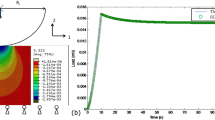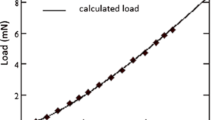Abstract
A comprehensive study on the spherical indentation of hyperelastic soft materials is carried out through combined theoretical, computational, and experimental efforts. Four widely used hyperelastic constitutive models are studied, including neo-Hookean, Mooney–Rivlin, Fung, and Arruda–Boyce models. Through dimensional analysis and finite element simulations, we establish the explicit relations between the indentation loads at given indentation depths and the constitutive parameters of materials. Based on the obtained results, the applicability of Hertzian solution to the measurement of the initial shear modulus of hyperelastic materials is examined. Furthermore, from the viewpoint of inverse problems, the possibility to measure some other properties of a hyperelastic material using spherical indentation tests, e.g., locking stretch, is addressed by considering the existence, uniqueness, and stability of the solution. Experiments have been performed on polydimethylsiloxane to validate the conclusions drawn from our theoretical analysis. The results reported in this study should help identify the extent to which the mechanical properties of hyperelastic materials could be measured from spherical indentation tests.












Similar content being viewed by others
References
ABAQUS (2009) ABAQUS user’s manual, version 6.9
Arruda EM, Boyce MC (1993) A three-dimensional constitutive model for the large stretch behavior of rubber elastic materials. J Mech Phys Solids 41:389–412
Barenblatt GI (1996) Scaling, self-similarity, and intermediate asymptotics. Cambridge University Press, Cambridge, MA
Ben Amar M, Goriely A (2005) Growth and instability in elastic tissues. J Mech Phys Solids 53:2284–2319
Cao YP, Lu J (2004a) Depth-sensing instrumented indentation with dual sharp indenters: stability analysis and corresponding regularization schemes. Acta Mater 52:1143–1153
Cao YP, Lu J (2004b) A new method to extract the plastic properties of metal materials from an instrumented spherical indentation loading curve. Acta Mater 52:4023–4032
Cheng YT, Cheng CM (1998) Relationships between hardness, elastic modulus, and the work of indentation. Appl Phys Lett 73:614–616
Cheng YT, Cheng CM (2004) Scaling, dimensional analysis, and indentation measurements. Mater Sci Eng R-Rep 44:91–149
Chen ZY, Diebels S (2012) Nanoindentation of hyperelastic polymer layers at finite deformation and parameter re-identification. Arch Appl Mech 82:1041–1056
Crichton ML, Donose BC, Chen X, Raphael AP, Huang H, Kendall MAF (2011) The viscoelastic, hyperelastic and scale dependent behaviour of freshly excised individual skin layers. Biomaterials 32:4670–4681
Cross SE, Jin YS, Rao JY, Gimzewski JK (2007) Nanomechanical analysis of cells from cancer patients. Nat Nanotech 2:780–783
Dao M, Chollacoop N, Van Vliet KJ, Venkatesh TA, Suresh S (2001) Computational modeling of the forward and reverse problems in instrumented sharp indentation. Acta Mater 49:3899–3918
Fischer-Cripps AC (2011) Nanoindentation. Springer, New York
Fung YC (1993) Biomechanics: mechanical properties of living tissues. Springer, New York
Fung YC, Fronek K, Patitucci P (1979) Pseudoelasticity of arteries and the choice of its mathematical expression. Am J Physiol-Heart C 237:H620–H631
Giannakopoulos AE, Triantafyllou A (2007) Spherical indentation of incompressible rubber-like materials. J Mech Phys Solids 55:1196–1211
Hadamard J (1923) Lectures on Cauchy’s problems in linear partial differential equations. Yale University Press, New Haven, CT
Holzapfel GA, Ogden RW (2006) Mechanics of biological tissue. Springer, Berlin
Humphrey JD (2003) Continuum biomechanics of soft biological tissues. Proc R Soc A 459:3–46
Lee B, Han L, Frank EH, Chubinskaya S, Ortiz C, Grodzinsky AJ (2010) Dynamic mechanical properties of the tissue-engineered matrix associated with individual chondrocytes. J Biomech 43:469–476
Lee H, Pharr GM, Nahm SH (2003) Material property evaluation of hyper-elastic rubber by micro-indentation. In: Proceedings of the SEM annual conference and exposition on experimental and applied mechanics
Levental I, Georges PC, Janmey PA (2007) Soft biological materials and their impact on cell function. Soft Matter 3:299–306
Li B, Cao YP, Feng XQ, Gao H (2012) Mechanics of morphological instabilities and surface wrinkling in soft materials: a review. Soft Matter 8:5728–5745
Lin D, Shreiber D, Dimitriadis E, Horkay F (2009) Spherical indentation of soft matter beyond the Hertzian regime: numerical and experimental validation of hyperelastic models. Biomech Model Mech 8:345–358
Liu D, Zhang Z, Sun L (2010) Nonlinear elastic load-displacement relation for spherical indentation on rubberlike materials. J Mater Res 25:2197–2202
Mooney M (1940) A theory of large elastic deformation. J Appl Phys 11:582–592
Oliver WC, Pharr GM (1992) Improved technique for determining hardness and elastic modulus using load and displacement sensing indentation experiments. J Mater Res 7:1564–1583
Rivlin RS (1948) Large elastic deformations of isotropic materials. IV. Further developments of the general theory. Philos Trans R Soc Lond Ser A Math Phys Sci 241:379–397
Rodriguez EK, Hoger A, McCulloch A (1994) Stress-dependent finite growth in soft elastic tissue. J Biomech 27:455–467
Samani A, Plewes D (2004) A method to measure the hyperelastic parameters of ex vivo breast tissue samples. Phys Med Biol 49:4395–4405
Taber LA (1995) Biomechanics of growth, remodeling, and morphogenesis. Appl Mech Rev 48:487–545
Acknowledgments
Supports from the National Natural Science Foundation of China (Grant Nos. 11172155, 10972112), Tsinghua University (2012Z02103 and 20121087991) and 973 Program of MOST (2010CB631005) are acknowledged.
Author information
Authors and Affiliations
Corresponding author
Rights and permissions
About this article
Cite this article
Zhang, MG., Cao, YP., Li, GY. et al. Spherical indentation method for determining the constitutive parameters of hyperelastic soft materials. Biomech Model Mechanobiol 13, 1–11 (2014). https://doi.org/10.1007/s10237-013-0481-4
Received:
Accepted:
Published:
Issue Date:
DOI: https://doi.org/10.1007/s10237-013-0481-4




